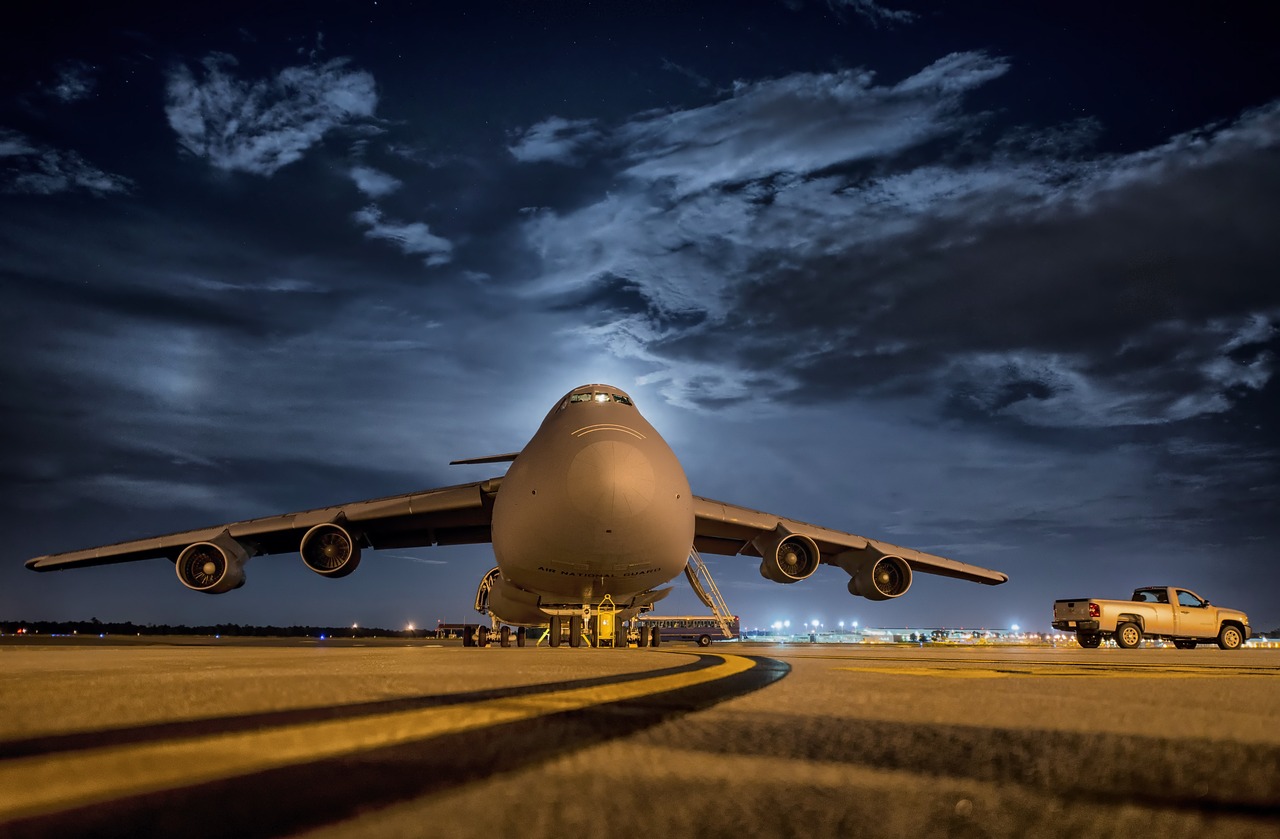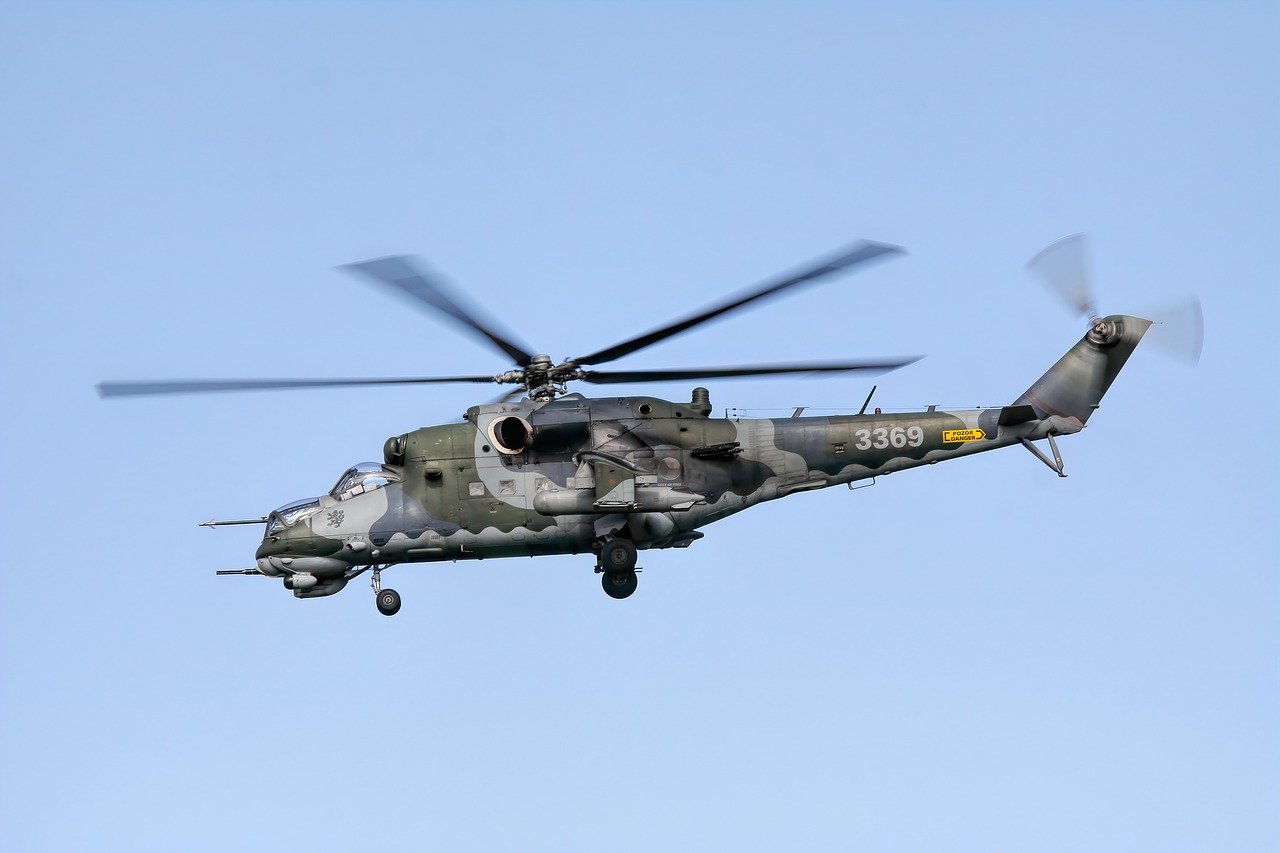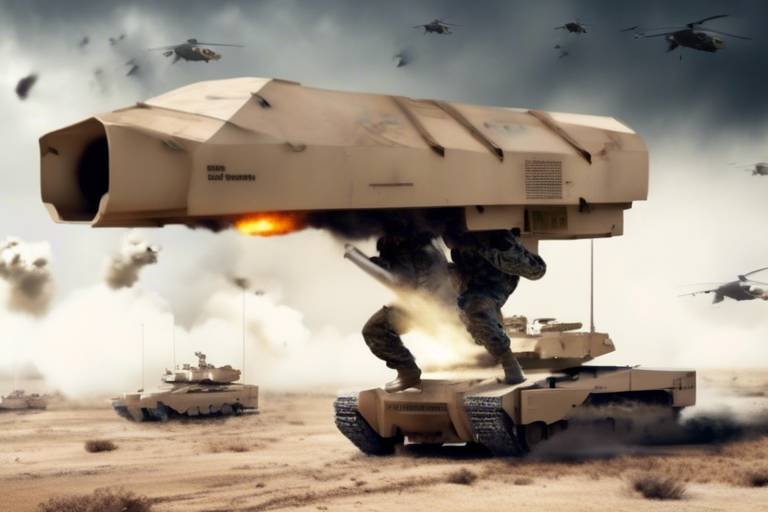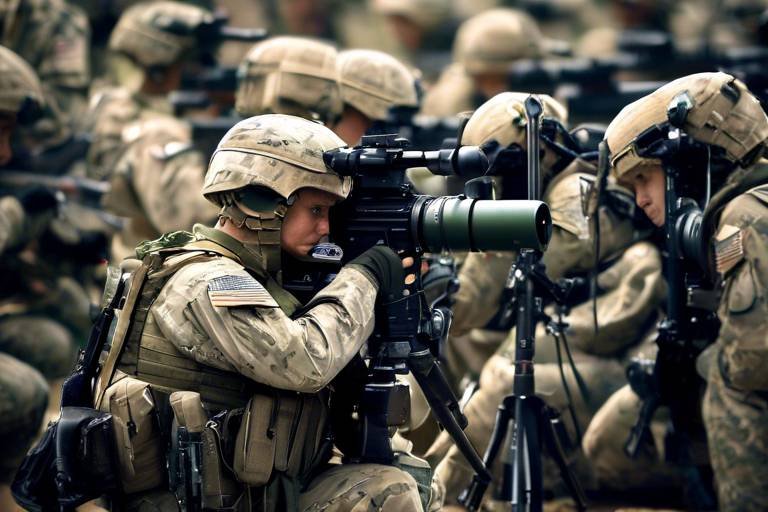How Advanced Defense Systems Enhance Military Effectiveness
The landscape of modern warfare is constantly evolving, and at the heart of this transformation are advanced defense systems. These systems are not just tools; they are the backbone of military effectiveness, shaping strategies and influencing outcomes in ways we could only dream of a few decades ago. Imagine a chess game where each piece is equipped with the ability to see the entire board and anticipate moves before they happen. That's the kind of advantage advanced defense systems provide to military forces around the globe.
In today's world, where threats can emerge from any direction—be it aerial, terrestrial, or even cyber—having a robust defense mechanism is crucial. Advanced systems are designed to detect, assess, and counteract these threats with remarkable precision and speed. They integrate cutting-edge technologies that enhance situational awareness and operational efficiency, allowing military leaders to make informed decisions in real-time. This capability is not just about reacting to threats; it's about staying one step ahead of adversaries.
Moreover, the integration of these advanced systems into military operations has revolutionized how strategies are formulated and executed. They allow for a more dynamic approach to warfare, where adaptability and responsiveness are key. For example, consider the role of radar technology in detecting incoming missiles or hostile aircraft. This technology has evolved significantly, with advancements such as phased array radars that can track multiple targets simultaneously and provide instant data to commanders.
But it doesn't stop there. The synergy between advanced defense systems and cybersecurity is becoming increasingly vital. As military operations become more digitized, safeguarding these systems from cyber threats is essential. This dual focus on physical and cyber defense ensures that military forces are not only prepared for traditional combat scenarios but are also equipped to handle the complexities of modern warfare.
In essence, advanced defense systems are not just about hardware; they represent a paradigm shift in how military forces operate. By leveraging the latest technologies, these systems empower armed forces to be more effective, agile, and resilient in the face of evolving threats. In the following sections, we will delve deeper into the evolution of defense systems, key technologies that drive them, and the critical role of cybersecurity in maintaining military effectiveness.
Understanding the historical development of defense systems provides insights into how military strategies have changed over time and the technological advancements that have shaped modern warfare. The journey from rudimentary defensive measures to sophisticated systems is a testament to human ingenuity and the relentless pursuit of security.
This section highlights the critical technologies that underpin advanced defense systems, including radar, missile defense, and cyber capabilities, which enhance situational awareness and operational efficiency.
Radar technology plays a vital role in detecting and tracking threats, allowing for timely responses. This subsection discusses advancements in radar systems and their significance in modern military operations.
Phased array radars offer enhanced tracking capabilities and faster response times. This part examines their applications in various military scenarios and their advantages over traditional radar systems.
Ground-based radar systems are essential for monitoring airspace and detecting incoming threats. This section details their operational roles and integration into defense strategies.
Missile defense systems are crucial for protecting assets from aerial threats. This subsection explores the different types of missile defense technologies and their effectiveness in modern warfare.
Cybersecurity is increasingly important in protecting defense systems from cyber threats. This section addresses the challenges and strategies for safeguarding military operations in the digital age.
Understanding potential cyber threats is essential for effective defense planning. This subsection discusses methods for assessing and managing cybersecurity risks in military operations.
Integrating cyber defense with traditional military systems enhances overall security. This part examines how military organizations can harmonize their cyber and physical defense strategies for optimal effectiveness.
- What are advanced defense systems?
Advanced defense systems refer to the latest technologies and strategies used by military forces to detect, track, and neutralize threats effectively. - How do radar systems improve military effectiveness?
Radar systems enhance military effectiveness by providing real-time data on potential threats, allowing for timely decisions and actions. - Why is cybersecurity important in military operations?
Cybersecurity is crucial because it protects sensitive information and systems from cyber attacks, ensuring the integrity and effectiveness of military operations.

The Evolution of Defense Systems
When we think about the evolution of defense systems, it's like watching a thrilling movie unfold over centuries. Imagine a time when armies relied solely on swords and shields, and then fast forward to today, where technology reigns supreme on the battlefield. The journey from rudimentary weapons to sophisticated systems is not just a tale of innovation; it’s a reflection of the changing dynamics of warfare and the relentless quest for national security.
Historically, defense systems have evolved in response to the threats of the time. In the early days, fortifications were built to protect against invading forces, and the focus was on physical barriers. However, as technology advanced, so did the strategies. The introduction of gunpowder changed the landscape, leading to the development of cannons and firearms. This shift marked the beginning of a new era where offensive capabilities began to outpace defensive strategies.
By the 20th century, the world saw the advent of mechanized warfare during the World Wars. Tanks, aircraft, and naval vessels became the cornerstones of military might. Each conflict prompted nations to innovate further, leading to the creation of advanced weaponry and defense systems. The Cold War era introduced the concept of nuclear deterrence, where the threat of mutually assured destruction shaped military strategies globally.
As we entered the 21st century, the landscape of warfare transformed yet again with the rise of information technology. Cyber capabilities emerged, allowing for a new frontier in warfare that didn’t rely solely on physical might. This shift highlighted the importance of intelligence, surveillance, and reconnaissance (ISR) systems. Countries began to invest heavily in these technologies to gain an upper hand, leading to a more interconnected and complex battlefield environment.
Today, advanced defense systems are not just about physical assets; they encompass a broad range of technologies designed to enhance military effectiveness. These systems integrate radar technologies, missile defense, and cybersecurity measures to create a cohesive defense strategy. The evolution has been so profound that it’s almost as if we’re living in a science fiction novel, where drones and automated systems are now commonplace on the battlefield.
In summary, the evolution of defense systems reflects the continuous interplay between technology and strategy. As threats evolve, so too must our defenses. The remarkable progress we’ve made showcases human ingenuity and the unwavering commitment to protecting our nations. It’s a story that is still being written, and as we look to the future, one can only wonder what the next chapter will hold.

Key Technologies in Advanced Defense Systems
In the ever-evolving landscape of modern warfare, advanced defense systems rely heavily on cutting-edge technologies that enhance their operational capabilities. These technologies not only improve situational awareness but also ensure rapid response to threats, ultimately boosting military effectiveness. Among these critical technologies, radar systems, missile defense systems, and cyber capabilities stand out as pivotal components that redefine how military operations are conducted.
Radar technology, for instance, serves as the backbone of military detection and tracking operations. It allows forces to identify potential threats and monitor their movements in real-time. With advancements such as phased array radars, military personnel can achieve unparalleled tracking capabilities. These radars utilize electronic scanning to detect multiple targets simultaneously, significantly reducing response times compared to traditional radar systems. The ability to quickly adapt to changing battlefield conditions is crucial, especially when every second counts.
Another vital aspect of advanced defense systems is the implementation of missile defense systems. These systems are designed to intercept and neutralize incoming aerial threats, such as ballistic missiles and hostile aircraft. The integration of advanced technologies, such as interceptor missiles and tracking systems, allows for a layered defense strategy that enhances protection for both military assets and civilian populations. For instance, the Terminal High Altitude Area Defense (THAAD) system exemplifies the effectiveness of modern missile defense, providing a robust shield against a range of aerial threats.
Furthermore, the importance of cyber capabilities in advanced defense systems cannot be overstated. As military operations increasingly rely on digital infrastructure, the risk of cyber threats grows correspondingly. Cybersecurity measures are essential to protect sensitive data and maintain operational integrity. Military organizations are now focusing on integrating cyber defense with traditional systems, creating a cohesive strategy that addresses both physical and digital vulnerabilities. This integration ensures that forces can respond to threats in a comprehensive manner, safeguarding national security in an interconnected world.
To illustrate the significance of these technologies, consider the following table that outlines the key components of advanced defense systems:
| Technology | Description | Impact on Military Operations |
|---|---|---|
| Radar Systems | Detects and tracks aerial threats using electromagnetic waves. | Enhances situational awareness and response times. |
| Missile Defense Systems | Intercepts and neutralizes incoming missiles and aerial threats. | Provides a protective shield for assets and civilians. |
| Cyber Capabilities | Protects military networks and systems from cyber attacks. | Ensures operational integrity and data security. |
In conclusion, the integration of these key technologies into advanced defense systems not only enhances military effectiveness but also ensures a more secure operational environment. As threats evolve, so too must the technologies that protect against them. By continuously advancing radar, missile defense, and cyber capabilities, military organizations can maintain a strategic edge in an increasingly complex battlefield.
- What are the main technologies used in advanced defense systems?
The primary technologies include radar systems, missile defense systems, and cyber capabilities, each playing a crucial role in enhancing military operations.
- How do radar systems improve military effectiveness?
Radar systems enhance military effectiveness by providing real-time detection and tracking of threats, allowing for quicker responses and better situational awareness.
- Why is cybersecurity important in military operations?
Cybersecurity is vital to protect sensitive military data and ensure the integrity of defense operations, especially as reliance on digital systems increases.

Radar Technology
Radar technology stands as a cornerstone of modern military operations, playing a crucial role in detecting and tracking potential threats. Imagine being in a vast ocean where danger lurks beneath the surface, yet your radar acts as a lighthouse, illuminating the path and guiding you safely. This technology has evolved significantly over the years, transitioning from basic systems to complex networks that provide real-time situational awareness. The advancements in radar capabilities have transformed how military forces strategize and respond to threats, ensuring that they remain one step ahead of adversaries.
One of the most significant advancements in radar technology is the development of phased array radars. These systems utilize a series of antennas that can steer the radar beam electronically, allowing for rapid tracking of multiple targets simultaneously. Unlike traditional radar systems, which require physical movement to change direction, phased array radars can adjust their focus almost instantaneously. This feature is particularly advantageous in dynamic combat scenarios where every second counts. For instance, during an aerial engagement, the ability to track multiple incoming missiles or aircraft can mean the difference between success and failure.
Furthermore, ground-based radar systems play an essential role in monitoring airspace and identifying incoming threats, such as enemy aircraft or missiles. These systems are strategically placed to provide comprehensive coverage and are often integrated with other defense mechanisms to create a layered security approach. The operational roles of ground-based radar systems include:
- Early warning detection of aerial threats
- Tracking and identifying friendly and enemy aircraft
- Coordinating with missile defense systems for intercept operations
In addition to their tracking capabilities, modern radar systems are equipped with advanced signal processing technologies that enhance their effectiveness. These systems can filter out background noise and focus on genuine threats, significantly reducing false alarms. This is akin to having a highly trained guard dog that can distinguish between a harmless passerby and a potential intruder. As a result, military personnel can make informed decisions quickly, increasing their operational efficiency and effectiveness in combat situations.
Moreover, radar technology is not just limited to air defense; it has applications in naval and ground operations as well. For example, naval vessels use radar to navigate through treacherous waters and to detect enemy ships or submarines. Similarly, ground forces utilize mobile radar units to provide situational awareness in combat zones, ensuring that they remain vigilant against surprise attacks. The integration of radar technology across various military branches exemplifies its versatility and importance in modern warfare.
In conclusion, radar technology has undergone remarkable advancements that have significantly enhanced military effectiveness. From phased array systems that provide rapid tracking capabilities to ground-based units that ensure comprehensive airspace surveillance, radar systems are indispensable in today's defense landscape. As military strategies continue to evolve, the role of radar technology will undoubtedly expand, adapting to new challenges and ensuring that nations can protect their interests in an increasingly complex world.
- What is radar technology? Radar technology uses radio waves to detect and track objects, such as aircraft or missiles, providing critical situational awareness in military operations.
- How do phased array radars differ from traditional radar systems? Phased array radars can electronically steer their beams, allowing for quicker responses and the ability to track multiple targets simultaneously, unlike traditional systems that require physical movement.
- What are the applications of radar technology in military operations? Radar technology is used for air defense, naval navigation, and ground operations, providing essential information for threat detection and situational awareness.

Phased Array Radars
Phased array radars represent a significant leap forward in radar technology, revolutionizing how military forces detect and track aerial threats. Unlike traditional radar systems that rely on rotating antennas, phased array radars utilize a grid of multiple small antennas that can steer their beams electronically. This means they can track multiple targets simultaneously with incredible precision and speed. Imagine trying to catch a fly in a room using a flashlight that only points in one direction; it’s a challenge. Now, think about having a light that can illuminate the entire room at once, allowing you to see every movement. That’s the kind of advantage phased array radars provide.
One of the most compelling features of phased array radars is their ability to operate in adverse weather conditions. Traditional radar systems often struggle with rain, fog, or snow, but phased array systems maintain their effectiveness, ensuring that military operations can continue uninterrupted. This reliability is crucial, as it allows for real-time situational awareness, enabling commanders to make informed decisions quickly. In a military context, where every second counts, this capability can mean the difference between success and failure.
Furthermore, the integration of phased array radars into defense systems enhances overall battlefield awareness. For instance, they can be deployed on various platforms, including ships, aircraft, and ground installations. This flexibility allows for a multi-layered defense strategy, where different systems work together seamlessly to provide comprehensive coverage. A table illustrating the various applications of phased array radars can help clarify their versatility:
| Platform | Application |
|---|---|
| Naval Ships | Air defense and missile tracking |
| Aircraft | Target acquisition and tracking |
| Ground Installations | Surveillance and threat detection |
Moreover, phased array radars can quickly adapt to changing battlefield conditions. They can be reconfigured for different missions without the need for extensive downtime or physical adjustments. This adaptability is vital in modern warfare, where threats can emerge unexpectedly, and the ability to pivot quickly can provide a strategic edge. As military operations continue to evolve, the role of phased array radars will undoubtedly grow, solidifying their place as a cornerstone of advanced defense systems.
In conclusion, the advancements in phased array radar technology not only enhance tracking capabilities but also significantly improve response times in military operations. Their ability to function effectively in various environments, coupled with their versatility across different platforms, makes them an indispensable asset in the arsenal of modern defense systems. As we look to the future, it’s clear that these systems will play a pivotal role in shaping the landscape of military strategy and operations.
- What is a phased array radar? - A phased array radar is a type of radar system that uses an array of antennas to steer beams electronically, allowing for rapid tracking of multiple targets.
- How does phased array radar improve military operations? - It enhances detection capabilities, operates effectively in adverse weather, and allows for quick adaptability to changing battlefield conditions.
- Can phased array radars be used on different platforms? - Yes, they can be deployed on naval ships, aircraft, and ground installations for various applications.

Ground-Based Radar Systems
Ground-based radar systems are pivotal in the modern military landscape, serving as the eyes and ears of defense forces. These systems are strategically positioned to monitor airspace, providing a robust layer of surveillance that is crucial for early threat detection and response. Imagine a vast expanse of sky where potential threats loom, and ground-based radars act like vigilant sentinels, always on the lookout for any signs of danger. The integration of these systems into military operations enhances situational awareness, allowing commanders to make informed decisions rapidly.
One of the most significant advantages of ground-based radar systems is their ability to detect a wide range of aerial threats, from low-flying drones to high-altitude bombers. They operate by emitting radio waves that bounce off objects, returning data that can be analyzed to determine the distance, speed, and trajectory of incoming threats. This capability is crucial for ensuring the safety of strategic assets and civilian populations alike.
In addition to their detection capabilities, ground-based radar systems are designed to work in conjunction with other defense mechanisms. For example, they can provide real-time data to missile defense systems, allowing for coordinated responses to aerial threats. This synergy between ground-based radars and missile systems creates a multi-layered defense strategy that significantly enhances military effectiveness.
Furthermore, advancements in technology have led to the development of sophisticated ground-based radar systems that boast features such as:
- 3D Tracking: The ability to track targets in three dimensions, providing comprehensive situational awareness.
- Automatic Target Recognition: Advanced algorithms that can identify and classify threats automatically, reducing the workload on operators.
- Network Integration: Seamless communication with other military assets, enhancing the overall effectiveness of defense operations.
To illustrate the impact of ground-based radar systems, consider the following table that outlines key characteristics and capabilities:
| Feature | Description |
|---|---|
| Range | Typically ranges from 100 km to over 300 km, depending on the system. |
| Tracking Capability | Can track multiple targets simultaneously, providing a comprehensive threat overview. |
| Mobility | Some systems are mobile, allowing for rapid deployment and repositioning as needed. |
| Weather Resistance | Designed to operate effectively in various weather conditions, ensuring reliability. |
In conclusion, ground-based radar systems are indispensable in modern military operations. They not only enhance situational awareness but also facilitate a proactive defense strategy that can adapt to the ever-evolving landscape of aerial threats. As technology continues to advance, these systems will only become more sophisticated, ensuring that military forces remain a step ahead in protecting national security.
- What are ground-based radar systems used for?
Ground-based radar systems are primarily used for monitoring airspace, detecting aerial threats, and providing data to support military operations. - How do ground-based radars differ from airborne radars?
Ground-based radars are stationary and provide a broad field of view, while airborne radars are mounted on aircraft and can cover specific areas more dynamically. - Can ground-based radar systems operate in adverse weather conditions?
Yes, modern ground-based radar systems are designed to function effectively in various weather conditions, including rain, fog, and snow. - What is the future of ground-based radar technology?
The future of ground-based radar technology includes advancements in automation, artificial intelligence, and integration with other defense systems to enhance overall effectiveness.

Missile Defense Systems
Missile defense systems are a cornerstone of modern military strategy, providing essential protection against aerial threats that can jeopardize national security. In an era where conflicts can escalate rapidly and threats evolve continuously, these systems have become vital for safeguarding not only military installations but also civilian populations. Imagine a world where missiles are launched with the intent to destroy, and missile defense systems stand as a shield, intercepting these threats before they can cause devastation. This is the reality that advanced missile defense technologies strive to achieve.
At the heart of missile defense systems lies a combination of sophisticated technologies designed to detect, track, and neutralize incoming threats. These systems are categorized into several types, each tailored to address specific challenges posed by different kinds of missiles, whether they are short-range, medium-range, or intercontinental ballistic missiles (ICBMs). The effectiveness of these systems is not just in their ability to intercept a missile mid-flight but also in their integration with other defense mechanisms, creating a layered defense strategy that enhances overall security.
One of the most notable examples of missile defense systems is the Terminal High Altitude Area Defense (THAAD), which is designed to intercept short, medium, and intermediate-range ballistic missiles during their terminal phase of flight. THAAD utilizes advanced radar and interceptor technology, allowing it to track and destroy incoming threats at high altitudes. Another significant player in this arena is the Aegis Ballistic Missile Defense System, which is deployed on naval vessels and uses powerful radar to detect and engage incoming missiles over vast distances. The integration of these systems into a cohesive defense strategy is crucial for modern militaries, as they work in tandem to provide a robust shield against aerial attacks.
The effectiveness of missile defense systems can be further understood through a comparative analysis of different technologies. Below is a table summarizing key missile defense systems, their capabilities, and operational roles:
| Missile Defense System | Type | Operational Role | Key Features |
|---|---|---|---|
| THAAD | Ground-based | Terminal defense | High-altitude interception, mobile deployment |
| Aegis | Naval | Mid-course and terminal defense | Sea-based, advanced radar tracking |
| Patriot | Ground-based | Short to medium-range defense | Mobile, integrated with air defense systems |
As missile technology continues to advance, so too must our defense systems. The arms race in missile technology means that nations are constantly innovating, leading to the development of hypersonic missiles that can evade traditional defense systems. This reality necessitates that military organizations invest in research and development to keep pace with these emerging threats. The future of missile defense will likely include enhanced artificial intelligence capabilities, allowing for faster decision-making and more precise targeting.
In conclusion, missile defense systems are not just about intercepting missiles; they represent a complex web of technology, strategy, and international relations. As threats evolve, so too must our approaches to defense, ensuring that we remain one step ahead in protecting our nations from potential attacks. The dialogue surrounding missile defense is crucial, as it shapes the policies and strategies that underpin national security in a world that is increasingly volatile.
- What are missile defense systems? Missile defense systems are technologies designed to detect, track, and intercept incoming missiles to prevent them from reaching their targets.
- How do missile defense systems work? They utilize radar and interceptor missiles to identify and neutralize threats during various phases of missile flight.
- What is the difference between THAAD and Aegis? THAAD is a ground-based system focused on terminal phase interception, while Aegis is a naval system capable of mid-course and terminal defense.
- Why are missile defense systems important? They provide essential protection against aerial threats, ensuring the safety of military personnel and civilians alike.

The Role of Cybersecurity in Defense
In today's digital landscape, the role of cybersecurity in defense has become more critical than ever. As military operations increasingly rely on advanced technologies, the need to protect these systems from cyber threats is paramount. Imagine a battlefield where the enemy can disrupt communications or take control of military assets remotely; this is the reality we face if we neglect cybersecurity. It’s not just about protecting data anymore; it’s about safeguarding national security.
Cyber threats can manifest in various forms, from malware and phishing attacks to more sophisticated tactics like ransomware and state-sponsored hacking. Each of these threats poses unique challenges for military organizations. For instance, a successful cyber attack could compromise sensitive information or disrupt critical operations, leading to catastrophic consequences. Therefore, understanding these potential threats is essential for effective defense planning.
To combat these challenges, military organizations are adopting a multi-layered approach to cybersecurity. This includes not only advanced technological solutions but also training personnel to recognize and respond to cyber threats. The integration of cybersecurity into military operations is akin to fortifying a castle; you wouldn’t just build walls; you’d also ensure that the guards are trained and vigilant.
Moreover, the integration of cyber defense with traditional military systems is crucial for enhancing overall security. This synergy allows for a more comprehensive defense strategy that encompasses both physical and digital realms. For example, if a radar system is compromised, having a robust cyber defense can help mitigate the damage and restore functionality quickly. This interconnectedness is vital, as the lines between cyber and physical threats continue to blur.
In the face of evolving threats, military organizations must also prioritize threat assessment and management. This involves regularly evaluating potential vulnerabilities and implementing strategies to address them. A proactive approach is essential; waiting for an attack to happen is like waiting for a storm without preparing an umbrella. By anticipating threats, military forces can develop contingency plans that ensure operational continuity even in the face of cyber disruptions.
Finally, it’s important to recognize that cybersecurity is not a one-time effort but an ongoing process. As technologies evolve, so do the tactics employed by adversaries. Continuous training, regular updates to security protocols, and a culture of vigilance are necessary to stay ahead in this ever-changing landscape. Just as a soldier must remain alert and adaptable on the battlefield, so too must cybersecurity professionals be ready to respond to new challenges.
In summary, the role of cybersecurity in defense is multifaceted and indispensable. By understanding the threats, integrating cyber defense with traditional systems, and maintaining a proactive stance, military organizations can enhance their overall effectiveness and ensure national security in the digital age.
- What are the main cyber threats faced by military organizations?
The main cyber threats include malware, phishing attacks, ransomware, and state-sponsored hacking, all of which can disrupt military operations and compromise sensitive data.
- How can military organizations integrate cybersecurity into their operations?
They can integrate cybersecurity by adopting multi-layered security strategies, training personnel, and ensuring that cyber defense is part of overall military strategy.
- Why is continuous training important for cybersecurity?
Continuous training is essential because cyber threats are constantly evolving, and personnel must stay updated on the latest tactics and technologies to effectively counter these threats.

Threat Assessment and Management
In today's digital battlefield, understanding potential cyber threats is not just a precaution; it's a necessity. Military operations are increasingly reliant on interconnected systems, making them more vulnerable to cyber attacks. This reality underscores the importance of in the defense sector. By identifying, evaluating, and prioritizing potential risks, military organizations can develop robust strategies to mitigate these threats effectively.
One of the first steps in threat assessment is to conduct a comprehensive analysis of the current cyber landscape. This involves identifying various types of threats, including malware, phishing attacks, and insider threats. Each of these threats can have devastating impacts on military operations, potentially compromising sensitive information or disrupting critical systems. For instance, a successful phishing attack could grant unauthorized access to classified communications, leading to dire consequences.
Once potential threats are identified, the next step is to evaluate their likelihood and impact. This is where the concept of risk management comes into play. Military organizations often utilize a risk matrix to categorize threats based on their severity and probability. This matrix helps prioritize which threats require immediate attention and resources. For example, a threat with a high likelihood of occurrence and severe consequences would be addressed before a less likely, lower-impact threat.
| Threat Type | Likelihood | Impact | Priority Level |
|---|---|---|---|
| Phishing Attacks | High | Severe | 1 |
| Ransomware | Medium | High | 2 |
| Insider Threats | Low | Critical | 3 |
With a clear understanding of the threats and their priorities, military organizations can then implement appropriate measures to manage these risks. This often involves a combination of technological solutions and personnel training. For instance, investing in advanced firewalls and intrusion detection systems can significantly bolster defenses against cyber attacks. However, technology alone is not enough. Regular training sessions for personnel on recognizing phishing attempts and other cyber threats are equally vital. After all, the human element is often the weakest link in cybersecurity.
Moreover, continuous monitoring and updating of threat assessments are crucial. The cyber landscape is ever-evolving, with new threats emerging regularly. Therefore, military organizations must remain agile, adapting their strategies to counteract these evolving threats. This proactive approach not only enhances the overall security posture but also ensures that military operations can continue smoothly, even in the face of potential cyber disruptions.
In conclusion, effective threat assessment and management are foundational components of modern military strategy in the digital age. By understanding the landscape of cyber threats and implementing robust risk management practices, military organizations can safeguard their operations and maintain national security. As we move forward, the integration of advanced technologies with comprehensive training and continuous monitoring will be essential in staying one step ahead of potential adversaries.
- What is threat assessment in military operations?
Threat assessment involves identifying, evaluating, and prioritizing potential cyber threats to military operations to develop effective mitigation strategies. - Why is cybersecurity important for the military?
Cybersecurity is crucial because military operations increasingly rely on interconnected systems, making them vulnerable to cyber attacks that could compromise sensitive information. - How often should threat assessments be updated?
Threat assessments should be updated regularly to account for the evolving cyber landscape and emerging threats. - What role does personnel training play in managing cyber threats?
Personnel training is essential as it equips military staff with the knowledge to recognize and respond to cyber threats effectively, reducing the risk of successful attacks.

Integrating Cyber Defense with Traditional Systems
In today's rapidly evolving battlefield, the integration of cyber defense with traditional military systems has become not just beneficial but essential. Think of it like building a fortress: while strong walls and armed guards are crucial, having a robust surveillance system that can detect intruders from miles away is equally important. This integration ensures that military forces can respond to threats in real-time, whether they come from the air, land, or cyberspace.
One of the key challenges in this integration is the disparity between the speed at which cyber threats evolve and the pace at which traditional military systems can adapt. Cyber threats can emerge overnight, exploiting vulnerabilities in systems that have been in place for decades. Therefore, military organizations must prioritize flexibility and adaptability in their defense strategies. This means not only investing in advanced technologies but also fostering a culture of continuous learning and improvement within their ranks.
To achieve this integration effectively, it is crucial to establish a seamless communication framework between cyber and traditional defense units. For instance, when a cyber attack is detected, traditional military units must be informed immediately so they can adjust their operations accordingly. This requires a collaborative approach that breaks down silos between different branches of the military. Regular joint exercises that simulate cyber and physical attacks can enhance this cooperation, ensuring that all units are on the same page when it comes to threat response.
Moreover, the integration of cyber defense with traditional systems can enhance situational awareness. By employing advanced analytics and machine learning, military organizations can process vast amounts of data from both cyber and traditional sources. This data fusion not only helps in identifying patterns and potential threats but also aids in strategic decision-making. For example, if a cyber threat is detected that could compromise a military operation, commanders can quickly reassess their strategies based on real-time intelligence.
Ultimately, the successful integration of these systems hinges on training and education. Military personnel must be equipped with the skills to understand both cyber and traditional warfare. This means not only understanding the technologies involved but also grasping the implications of cyber operations on traditional military tactics. As the lines between cyber and physical warfare continue to blur, this holistic understanding will be critical to maintaining a strategic advantage on the battlefield.
- What are the main benefits of integrating cyber defense with traditional military systems?
This integration enhances situational awareness, improves response times, and fosters a collaborative defense approach against evolving threats. - How can military organizations ensure effective communication between cyber and traditional units?
By establishing a seamless communication framework and conducting regular joint exercises, organizations can enhance cooperation and readiness. - Why is continuous training important in this integration?
Continuous training ensures that military personnel are equipped with the skills and knowledge necessary to navigate the complexities of both cyber and traditional warfare.
Frequently Asked Questions
- What are advanced defense systems?
Advanced defense systems refer to sophisticated military technologies and strategies designed to protect national security. These systems include radar, missile defense, and cybersecurity measures that enhance military effectiveness in modern warfare.
- How have defense systems evolved over time?
The evolution of defense systems is a fascinating journey! From simple fortifications to complex technological frameworks, military strategies have continually adapted to new threats and advancements. This evolution reflects the changing nature of warfare and the increasing reliance on technology.
- What role does radar technology play in military operations?
Radar technology is crucial for detecting and tracking potential threats. It enables military forces to have a clearer picture of the battlefield, ensuring timely responses to incoming dangers. Advanced radar systems, like phased array radars, offer enhanced tracking capabilities and faster reaction times.
- What are missile defense systems, and why are they important?
Missile defense systems are designed to intercept and destroy incoming missiles before they can reach their targets. These systems are vital for protecting military assets and civilian populations from aerial threats, making them a cornerstone of modern defense strategies.
- How does cybersecurity impact military operations?
In today's digital age, cybersecurity is essential for protecting defense systems from cyber threats. With the rise of cyber warfare, military organizations must implement robust cybersecurity measures to safeguard their operations and maintain national security.
- What are the challenges in threat assessment and management?
Threat assessment and management in military operations involve identifying potential cyber threats and evaluating their impact. The challenges include staying ahead of rapidly evolving cyber threats and ensuring that defense strategies are adaptable and effective.
- How can military organizations integrate cyber defense with traditional systems?
Integrating cyber defense with traditional military systems is essential for a comprehensive security strategy. This integration allows for a more cohesive approach to defense, ensuring that both cyber and physical threats are addressed effectively, enhancing overall military effectiveness.



















